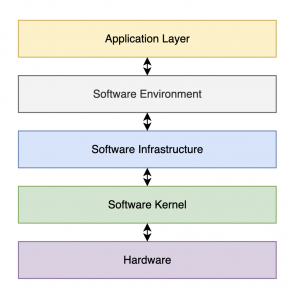Assignment Overview
In unit 1.3, the class was tasked with writing three separate definitions for a single, relatively complex term in our respective program disciplines. The types of definitions included are a parenthetical definition, a sentence definition, and an expanded definition. These are centred around a reading situation and are targeted at an audience of non-technical readers.
Reading Situation
A software engineer is describing the term “Cloud Architecture” to a client for which they are building a new service.
Definitions
Parenthetical Definition
Cloud Architecture (a design for a shared computing environment) is at the core of many of today’s most widely used applications.
Sentence Definition
Cloud Architecture is a computing design in which multiple computers are connected, with the aim of sharing and pooling processing power, memory, and storage capacity.
Expanded Definition
Operating Principle
Cloud architecture is a computing design in which multiple computers are connected to pool processing power, memory, and storage capacity (Kaisler & Money, 2011). Applications built using this design can distribute multiple tasks to different computers, thereby reducing the resource load on any given machine.
Compare and Contrast
A desktop application built on the architecture of a single computer can make use of one machine’s memory, storage, and processing power (also known as a computer’s resources). The demands of the application may therefore cause the computer to run slowly if it lacks sufficient resources. In contrast, an application built using cloud architecture can use the resources combined from multiple computers. Programs developed on cloud architecture can therefore run faster and support many concurrent users (Kaisler & Money, 2011).
Visual
It is typical for cloud architecture to consist of five main components known as abstraction layers, shown in Figure 1. Each layer represents a set of capabilities and responsibilities, which together facilitate the workings of the design (Hu et. al, 2011). For each layer to function, it requires the services provided by the layer underneath it.

Figure 1: Five Cloud Architecture Abstraction Layers (Hu et. al, 2011)
Analysis of Parts
The names and purposes of each are as follows:
- The Hardware Layer is the physical set of computers used to support the architecture. The raw data storage, processors, and memory are found in this layer (Hu et. al, 2011).
- The Software Kernel Layer is responsible for managing the storage, memory, and processing capacity of the hardware, based on instructions provided by the Software Infrastructure Layer (Hu et. al, 2011).
- The Software Infrastructure Layer provides access to the computing network to the Software Environment Layer. In this manner, it grants access to the computing resources provided in the Software Kernel Layer and the Hardware Layer (Hu et. al, 2011).
- The Software Environment Layer is used to implement and distribute programs created by software developers. It receives requests from the Application Layer, and interfaces with the Software Infrastructure Layer to distribute any required tasks (Hu et. al, 2011).
- The Application Layer contains the program that is accessed by the software application user. This is the forward facing portion of the software application that can be interacted with through the user interface. It sends requests to the Software Environment Layer. (Odun-Aro et. al, 2018).
Works Cited:
Hu, F., Qiu, M., Li, J., Grant, T., Taylor, D., McCaleb, S., Butler, L., & Hamner, R. (2011). A review on Cloud computing: Design challenges in architecture and security. Journal of Computing and Information Technology, 19(1), 25. https://doi.org/10.2498/cit.1001864
Kaisler, S., & Money, W. H. (2011). Service migration in a cloud architecture. 2011 44th Hawaii International Conference on System Sciences. https://doi.org/10.1109/hicss.2011.371
Odun-Ayo, I., Ananya, M., Agono, F., & Goddy-Worlu, R. (2018). Cloud computing architecture: A critical analysis. 2018 18th International Conference on Computational Science and Applications (ICCSA). https://doi.org/10.1109/iccsa.2018.8439638
Leave a Reply